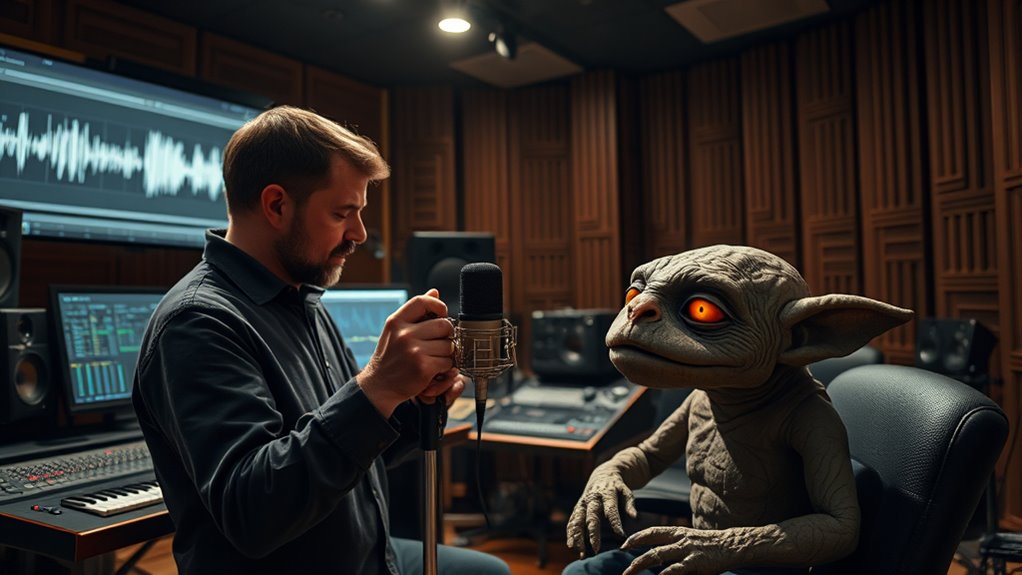To understand Gollum’s iconic voice in The Lord of the Rings, you need to look at a mix of vocal techniques, motion capture, and sound design. You’ll notice how the actor shifts pitch, adds rasp, and uses high-pitched inflections to reflect Gollum’s obsession and vulnerability. Behind the scenes, advanced puppetry and emotional performance by Andy Serkis bring Gollum’s physicality to life. Keep exploring to uncover how these elements combine for an unforgettable character experience.
Key Takeaways
- Vocal modulation techniques like pitch shifting and gravelly sounds create Gollum’s distinctive, haunting voice.
- Andy Serkis’s physical acting and puppetry control enhance the authenticity of Gollum’s gestures and expressions.
- Sound designers layer effects and distortions to blend raw recordings into Gollum’s unique vocal timbre.
- Facial capture technology records micro-movements, adding emotional depth and subtlety to Gollum’s voice.
- The combination of vocal techniques and physical performance deepens audience empathy and highlights Gollum’s complex psyche.
The Art of Voice Acting: Crafting Gollum’s Distinctive Sound
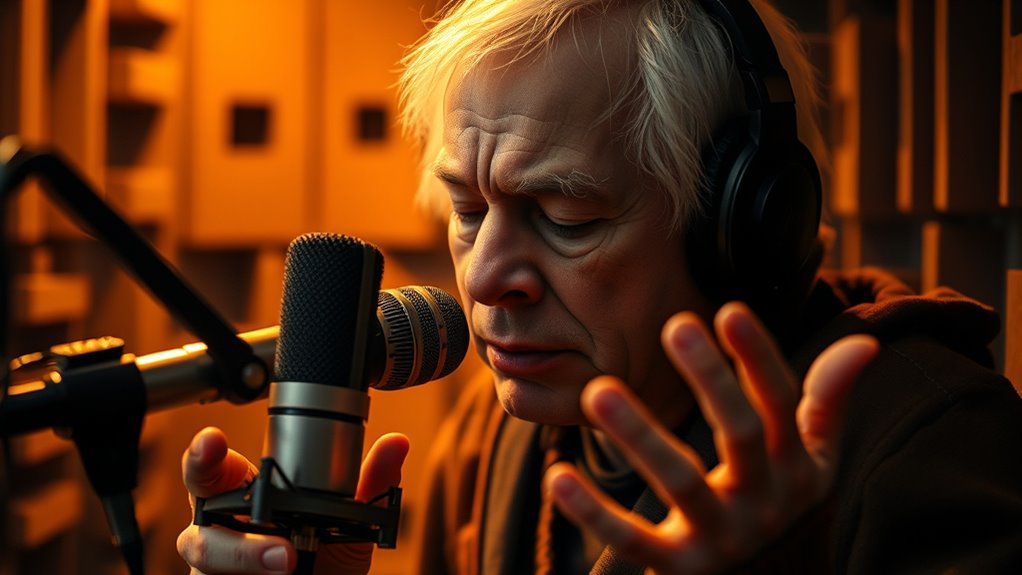
Creating Gollum’s voice requires a keen understanding of his complex personality and a mastery of vocal techniques. You must skillfully use puppet manipulation to bring his physicality into your performance, mimicking his twitchy, serpentine movements with your voice. Vocal modulation is essential; you shift pitch, tone, and cadence to capture his duality—both pitiful and menacing. You’ll experiment with raspy, gravelly sounds to evoke his worn, haunted nature, while also employing sharp, high-pitched inflections to reflect his obsessive obsession with the Ring. Every nuance of Gollum’s voice stems from a balance of puppet manipulation and vocal modulation, allowing you to embody his unpredictable, tormented soul convincingly. This artistic combination creates the distinctive, haunting sound that makes Gollum unforgettable. Additionally, understanding sound design techniques can further enhance the authenticity of his voice and presence.
Motion Capture Technology and Its Role in Gollum’s Portrayal
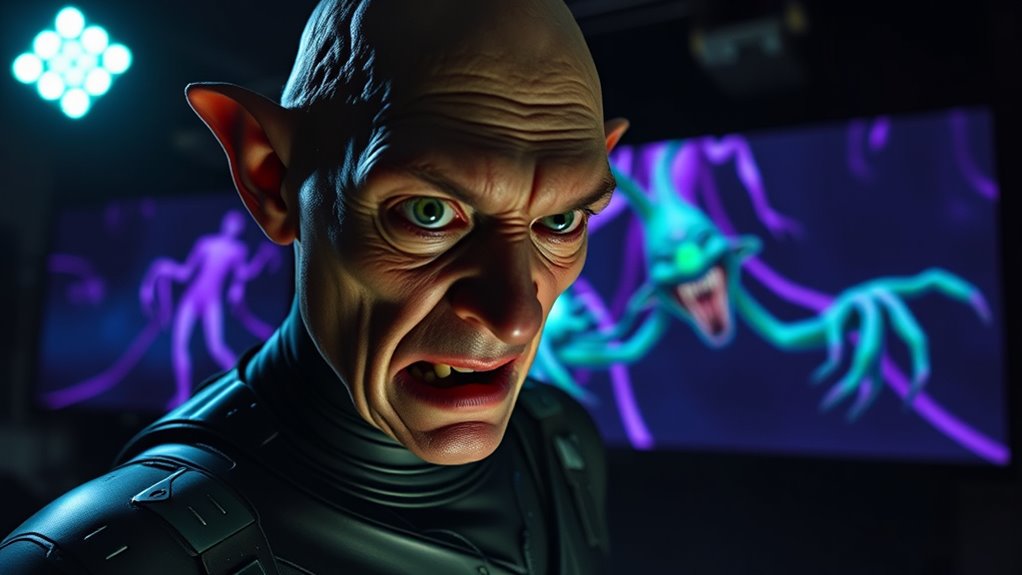
Motion capture technology has revolutionized how Gollum is brought to life on screen, allowing performers to embody his complex movements with unprecedented realism. Through digital puppetry, the actor’s physical actions are captured and translated into Gollum’s animated form, creating seamless, believable motion. Facial capture plays an essential role as well, recording subtle expressions and micro-movements that convey Gollum’s inner turmoil. This technology enables the character’s physicality and emotions to be intricately linked, making Gollum feel alive and authentic. By combining digital puppetry with detailed facial capture, filmmakers can craft a performance that captures the character’s quirks, tension, and vulnerability, immersing viewers fully in Gollum’s world. Additionally, the integration of natural materials in the motion capture suits helps to improve performer comfort and accuracy during filming. This synergy of tech and performance is key to Gollum’s mesmerizing presence.
The Sound Design Process: From Raw Voice to Iconic Character
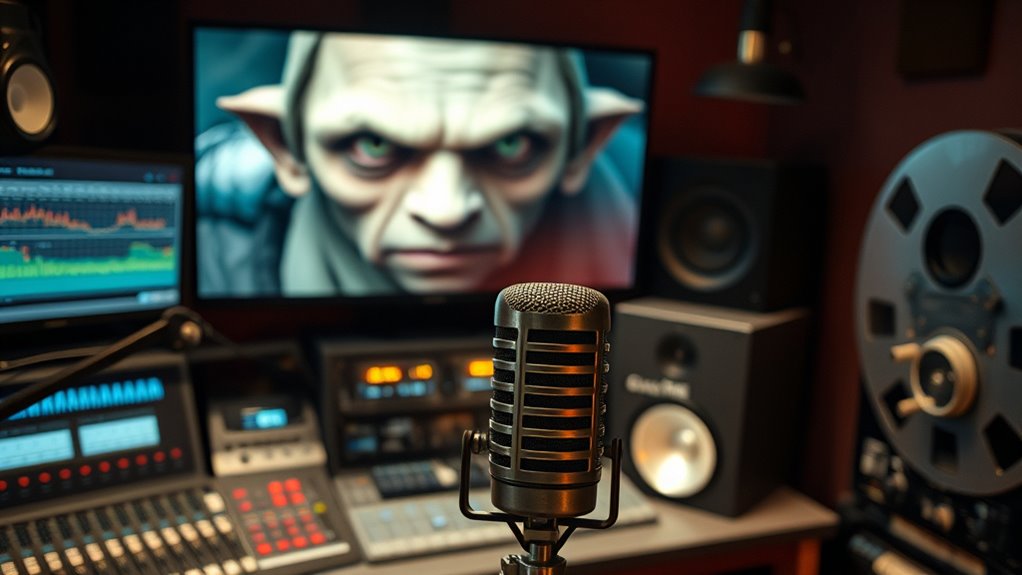
The transformation of Gollum’s voice from a raw recording into his distinctive, haunting persona involves a meticulous sound design process. You start with the actor’s voice, capturing raw performances that convey Gollum’s complex emotions. Then, sound layering comes into play—adding subtle effects, pitch adjustments, and distortions to emphasize his unsettling nature. These layers blend seamlessly to shape Gollum’s unique timbre, guiding audience perception of his character—making him sound both vulnerable and menacing. The goal is to craft a voice that feels alive and emotionally charged, enhancing Gollum’s personality. Every tweak and layer is carefully calibrated to evoke the right emotional response, ensuring viewers see Gollum not just as a creature but as a deeply real, memorable character. Additionally, understanding the sound design process involved in creating Gollum’s voice helps appreciate the technical artistry behind iconic characters.
Actor Andy Serkis’S Transformation Into Gollum
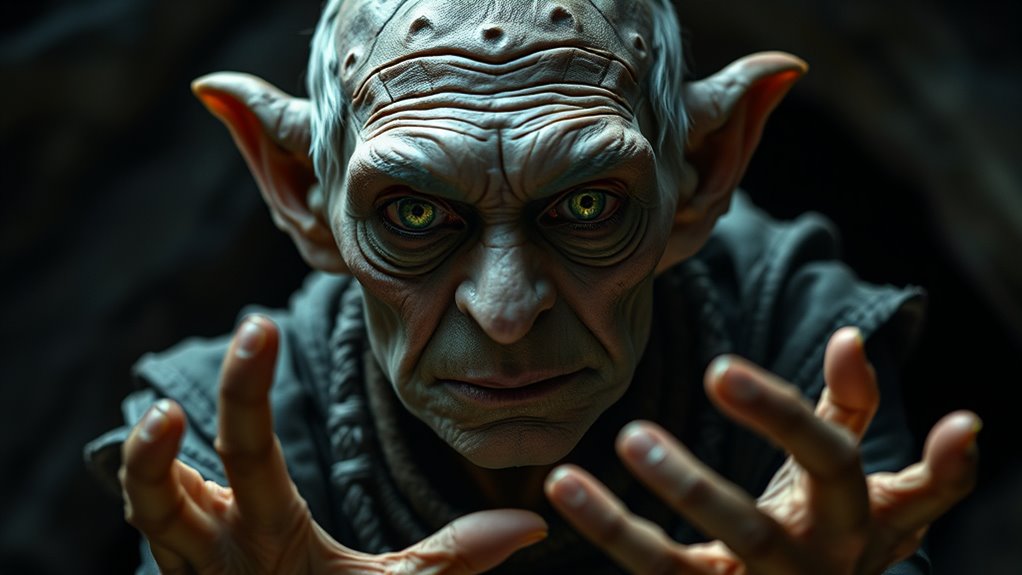
Andy Serkis’s transformation into Gollum goes beyond simply acting in front of a camera; it involves an intense physical and emotional immersion that blurs the line between performer and character. You’ll notice how puppet manipulation plays a key role, as Serkis expertly controls Gollum’s movements with precise gestures that bring the character’s awkwardness and agility to life. The costume design also enhances this transformation, with detailed prosthetics and a tailored suit that help Serkis embody Gollum’s hunched posture and distinctive features. Every movement, sound, and emotion you see is a result of Serkis’s dedication, blending puppetry, physical acting, and costume work seamlessly. This complex process allows you to connect deeply with Gollum’s fractured psyche, making the character feel utterly real. Additionally, Serkis’s mastery of physical acting techniques ensures that every nuance of Gollum’s behavior is convincingly portrayed, creating a truly immersive experience for viewers.
The Impact of Gollum’s Voice on Audience Immersion and Character Depth
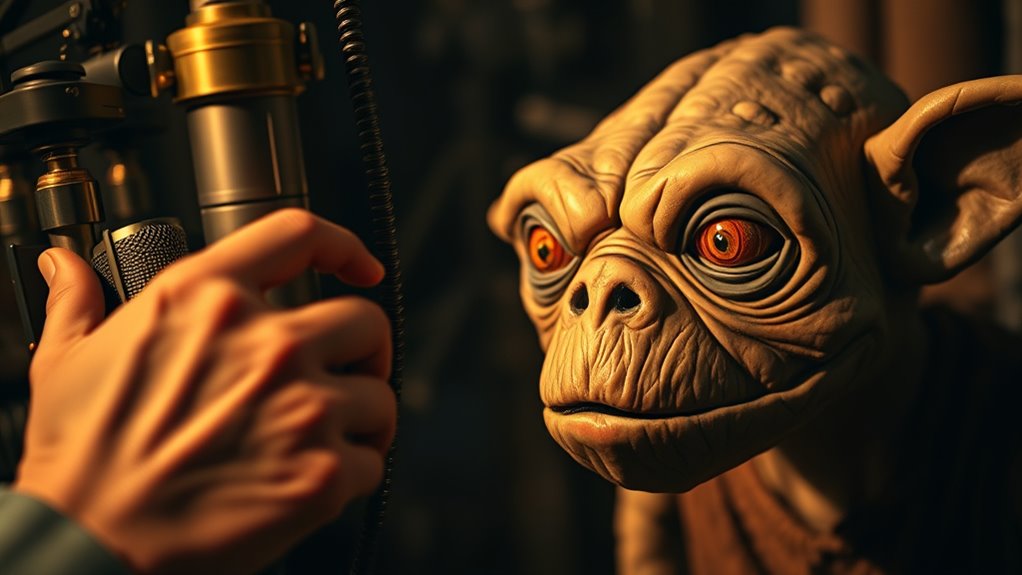
Gollum’s voice plays a pivotal role in shaping how you experience the character’s inner turmoil and unpredictability. It’s an emotionally resonant vocal characterization that draws you into his conflicted mind, making his struggles feel real. When you hear his raspy, trembling tones, you sense his obsession and vulnerability, deepening your connection to him. This unique vocal approach heightens audience immersion, allowing you to see beyond Gollum’s outward appearance and understand his complex psyche. The voice’s raw, unpredictable qualities amplify his character depth, transforming him from a simple creature into a tragic, multi-dimensional figure. Additionally, the voice’s distinctive vocal techniques contribute to establishing Gollum’s unsettling presence, reinforcing his status as both a victim and a villain. Ultimately, Gollum’s voice isn’t just a sound; it’s a bridge that brings you closer to feeling his pain, obsession, and fragile humanity.
Frequently Asked Questions
How Does Gollum’S Voice Influence His Psychological Portrayal?
Your understanding of Gollum’s voice reveals how voice modulation adds emotional depth, shaping his psychological portrayal. By using fluctuating tones and pitch, the voice reflects his inner torment, obsession, and split personality. You sense his vulnerability and malevolence, making him more complex and believable. This vocal technique immerses you in his fractured mind, allowing you to connect emotionally and see beyond his sinister exterior.
What Challenges Are Involved in Blending Voice Acting With Motion Capture?
You face the challenge of seamlessly blending motion capture with voice synchronization, ensuring Gollum’s movements match his haunting voice. This requires precise timing, as any misalignment can break immersion. You must coordinate actors’ facial expressions and physical gestures with voice recordings, making sure both elements complement each other perfectly. Overcoming these hurdles creates a more believable, compelling character that feels alive and true to the story.
How Is Gollum’S Voice Adapted Across Different Media Formats?
When you explore how Gollum’s voice adapts across media formats, you see voice modulation plays a key role. In different media, voice actors adjust tone and pitch to suit the platform, whether it’s film, video games, or animation. This media adaptation ensures Gollum’s character remains enthralling and consistent, regardless of the format. You’ll notice these subtle changes help maintain the character’s eerie, unsettling presence across various media.
What Role Does Sound Engineering Play in Gollum’S Character Evolution?
Sound engineering plays a vital role in shaping Gollum’s character evolution by utilizing voice modulation and sound layering. You can hear how voice modulation transforms the actor’s voice to sound eerie and unpredictable, while sound layering adds depth and complexity, reflecting Gollum’s conflicted personality. These techniques help create an immersive experience, making Gollum’s character more compelling and believable, and allowing his emotional nuances to resonate more effectively with the audience.
How Do Actors Prepare to Voice Complex Characters Like Gollum?
Imagine yourself stepping into Gollum’s shoes, feeling his torn emotions and dark obsession. To bring such a character to life, you focus on voice modulation and emotional depth, practicing different tones and expressions. You might record yourself, analyze your voice, and explore your own fears and desires to connect authentically. This preparation helps you deliver a nuanced performance, making Gollum’s complex personality both believable and haunting.
Conclusion
You might think creating Gollum’s voice was just about talent, but it’s actually a complex blend of technology and art. Ironically, despite all the high-tech gear and meticulous work, it’s the raw emotion and subtlety that truly bring Gollum to life. So next time you’re captivated by his haunting voice, remember—it’s not just the magic of sound, but the human touch behind it that makes him unforgettable. Sometimes, art’s greatest power lies in its imperfections.
